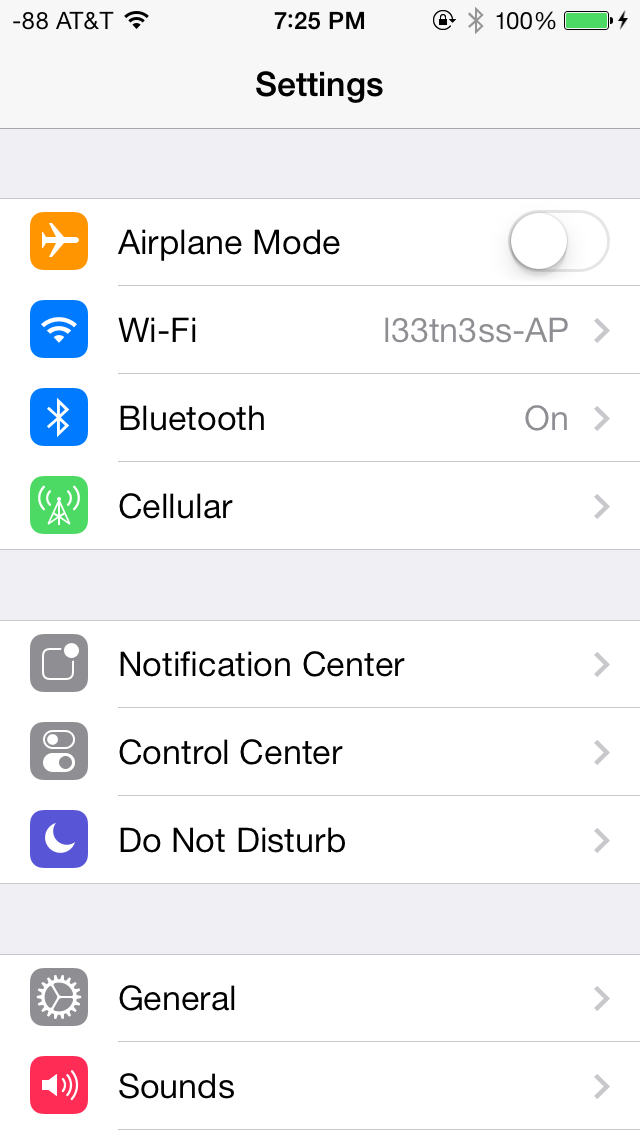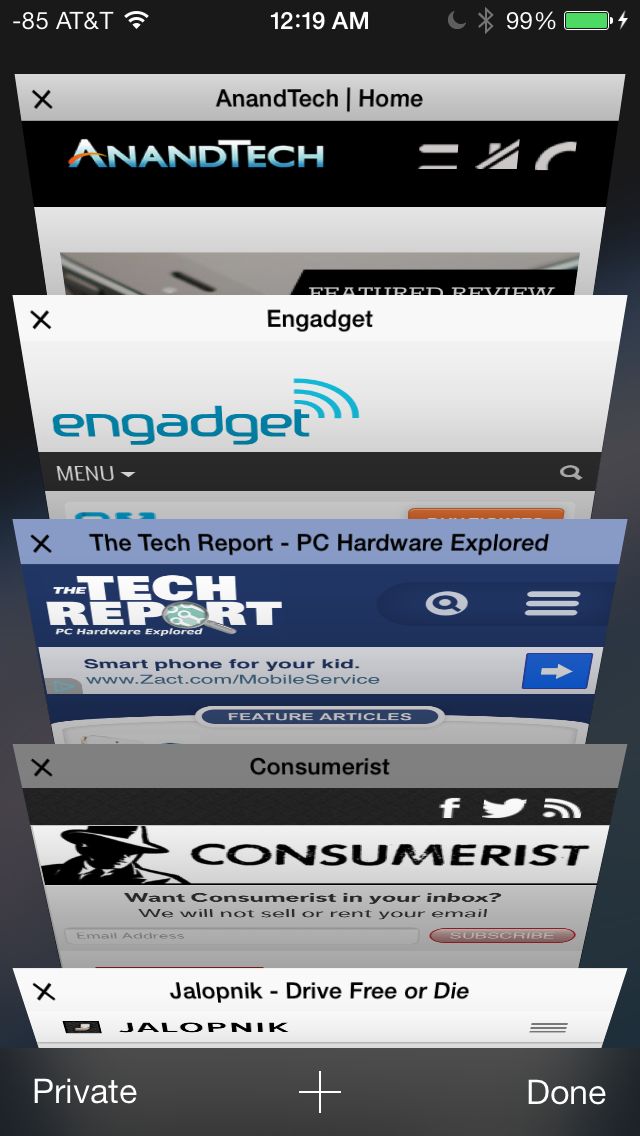The iOS 7 Review
by Brian Klug & Saumitra Bhagwat on September 19, 2013 1:25 AM ESTSettings
The changes in Settings.app are primarily visual at a high level. The application icon is perhaps the most curious change, since it looks like a sprocket for a bicycle or the gears inside a watch now, but I digress. This new UI pretty much just has visual style that matches the rest of iOS 7, and doesn’t really fundamentally change organizational structure very much. Settings are still grouped together in a couple of logical little bunches, with a bunch of third party application-specific settings options at the very bottom.
There’s obviously the addition of control center inside settings, and do not disturb comes outside of notifications. There are also the appropriate toggles for the today view under notification center. Under general and accessibility there are new options for the dynamic font size functionality, and a new toggle for disabling noise cancelation which proved somewhat controversial on the iPhone 5 (this setting also carries over to the 5s but not the 5c which I suspect lacks earpiece noise cancelation).

Safari
iOS 7 brings mobile safari version 7, which gets a huge set of functional changes and improvements to the JavaScript engine. Safari has been around for a while without many big changes to the interface, so this is big one.

There’s now a unibar at the top of the page for both URLs and search terms, this is a long overdue and welcome change that makes a ton of sense. Safari also now preloads the first result in the list while you’re typing, which has the side effect of making loading feel much faster regardless of what device you’re coming from.
The unibar also looks through bookmarks that are either synced through iCloud or exist on the iDevice and exposes those as options. It’s a bit confusing though since there are both the bookmarks under that appropriate menu, and bookmarks from the bookmarks bar that appear when you tap on the unibar on an empty tab before you start typing. I didn’t realize I even had some of those bookmarks still around until iOS 7 swung around and exposed them.
The new mobile safari gets the same transparent overlays and sense of depth that the rest of the OS conveys, the pages render below most of the UI and there’s a bit of hinting from elements that peek through. A big change is that the bottom menu now also slides away as you scroll down a page, expanding the viewport accordingly. The top bar gets smaller but retains the domain of the page being visited. Tweaks like these do help the iPhone feel bigger than it used to feel.
In addition you can now have more than 8 pages open at the same time, and safari seems a lot better at keeping tabs around and not reloading their contents every time you switch between them. The tab switching interface is also a lot better, with a card-like metaphor that allows for tabs to be quickly closed by just swiping them off the left of the display. The only slightly unnerving issue here is that the tabs aren’t antialiased during the animation and for a slight moment or two after it stops, then suddenly the edges no longer have jaggies. It’s a disconcerting subtle thing I can’t stop seeing every time I change tabs in the new mobile safari.
If the signal dots are my least favorite part of iOS, then the changes made in mobile safari and the addition of control center are my favorite.
Benchmarks
Apple usually makes improvements to its JavaScript engine (Nitro) whenever it can, and the iOS 7 mobile safari release is no exception. There’s a 15 percent difference in sunspider and browsermark, and a larger one closer to 50 percent in kraken and google octane, webxprt sees a 30 percent jump. This is comparing two iPhone 5 models running iOS 6.1.4 and the iOS 7.0 GM. HTML5 score increases as well with the addition of a few new features, and WebKit moves from 536.26 to 537.51.1.
| iOS 6.1.4 | iOS 7 GM | |
| Sunspider 1.0 (ms) | 836.6 | 721.1 |
| Browsermark 2.0 (score) | 2587 | 2998 |
| Kraken 1.1 (ms) | 20388.0 | 14050.6 |
| Google Octane (score) | 1706 | 2856 |
| WebXprt (score) | 176 | 231 |
| HTML5test.com (score) | 386+9 | 399+9 |













144 Comments
View All Comments
Spaz888 - Wednesday, October 2, 2013 - link
I've stopped updating all my apps now. I will not update to IOS 7. Too ugly for me. There is also a performance hit for those like me who have over a hundred apps installed on my iPhone 5. I am curious to know how much RAM the OS takes up over 6.1.4. If it is actually less (not likely) I might consider it, but given that battery life issues are becoming more apparent, the only time I will see a new iOS will be with my iPhone 6S and it will be iOS 9!Brakken - Thursday, October 3, 2013 - link
Music controls must stay in Control Centre as there's no more double-homebutton-click to access it anymore.Can anyone tell me if they've noticed the delete button function on the keyboard? It seems to jump across a space rather than just to the first letter of the word to be changed. It's not happening here, but it does on email.
I'm sorry for all the ppl who get motion sickness with iOS7, but for the most part, I love it!
I got the idea from the text resize slider function: how difficult would it be to implement a slider for movement, colour hue, and transparency?
maddalin - Sunday, October 6, 2013 - link
I had ios 7 beta on my iphone 5 until yesterday. Then I succesfully updated to 7.0.2 but the problem is I dont see any transparency or blurring. Everything is grey like it supposed to appear on iphone 4. Is there anywhere an option to enable this cool effect? On the beta version I had the same problem, but I thought it's supposed to appear like this because its betafareed0694 - Wednesday, January 1, 2014 - link
Hey friends, here is an iOS application which is used for sharing files using iphone/ipod/ipad bluetooth. Wanna know visit here - http://goo.gl/XSEDsU